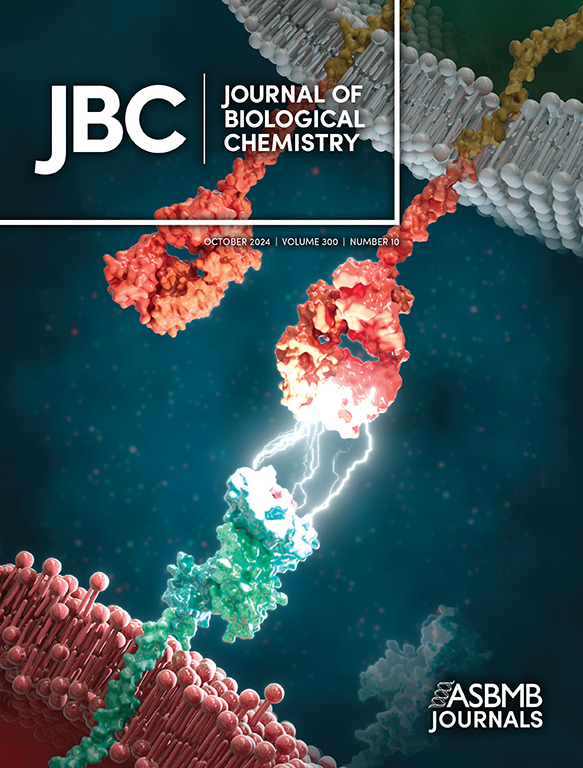基于生物发光的测定活细胞内源性蛋白相互作用的方法。
IF 4
2区 生物学
Q2 BIOCHEMISTRY & MOLECULAR BIOLOGY
引用次数: 0
摘要
蛋白质-蛋白质相互作用(PPIs)是细胞信号网络的组成部分,在癌症、神经变性、炎症和代谢紊乱中经常被破坏。靶向失调的PPI为开发治疗性化合物提供了一个有希望的策略。然而,传统的药物发现平台通常依赖于质粒驱动的过表达模型,这些模型无法复制天然细胞背景下PPI的复杂性和动态性。本研究旨在评估NanoLuc二元技术(NanoBiT)和NanoLuc生物发光共振能量转移(NanoBRET)在活细胞中用于定量内源性调节蛋白相互作用的应用。为了实现这一目标,使用crispr介导的基因组工程技术在ddd -1和HCT 116细胞系的EGFR/GRB2和KRas/CRAF位点上整合NanoBiT和NanoBRET融合标签。然后使用工程细胞系在单层培养中使用端点和动力学测量以及发光成像进行检测。该方法进一步扩展到研究癌症相关等基因细胞系和3D球体模型中的PPI,这些模型可以更好地保存细胞组织的其他方面。总的来说,这些发现建立了一个强大的模块化工作流程,用于生成内源性调节的PPI报告细胞系,以提高活细胞检测的相关性和预测能力。通过在更具代表性的背景下捕获相互作用动力学,该方法为阐明信号机制和表征靶向PPIs的治疗化合物提供了潜在的有价值的工具。本文章由计算机程序翻译,如有差异,请以英文原文为准。
Bioluminescence-based assays for quantifying endogenous protein interactions in live cells.
Protein-protein interactions (PPIs) are integral to cellular signaling networks and are frequently disrupted in cancer, neurodegeneration, inflammation, and metabolic disorders. Targeting dysregulated PPI presents a promising strategy for development of therapeutic compounds. However, traditional drug discovery platforms often rely on plasmid-driven overexpression models that fail to replicate the complexity and dynamics of PPI in native cellular contexts. This study aims to evaluate the use of NanoLuc Binary Technology (NanoBiT) and NanoLuc Bioluminescence Resonance Energy Transfer (NanoBRET) for quantifying interactions of endogenously regulated proteins in live cells. To achieve this, CRISPR-mediated genome engineering was used to integrate NanoBiT and NanoBRET fusion tags at the loci for EGFR/GRB2 and KRas/CRAF in DLD-1 and HCT 116 cell lines. Assays using the engineered cell lines were then conducted in monolayer cultures using endpoint and kinetic measurements, as well as luminescence imaging. The approach was further expanded to investigate PPI in cancer-associated isogenic cell lines and 3D spheroid models that better preserve additional aspects of cellular organization. Collectively, these findings establish a robust and modular workflow for generating endogenously regulated PPI reporter cell lines to improve relevance and predictive power of live-cell assays. By capturing interaction dynamics in a more representative background, this approach offers a potentially valuable tool for elucidating signaling mechanisms and characterizing therapeutic compounds targeting PPIs.
求助全文
通过发布文献求助,成功后即可免费获取论文全文。
去求助
来源期刊

Journal of Biological Chemistry
Biochemistry, Genetics and Molecular Biology-Biochemistry
自引率
4.20%
发文量
1233
期刊介绍:
The Journal of Biological Chemistry welcomes high-quality science that seeks to elucidate the molecular and cellular basis of biological processes. Papers published in JBC can therefore fall under the umbrellas of not only biological chemistry, chemical biology, or biochemistry, but also allied disciplines such as biophysics, systems biology, RNA biology, immunology, microbiology, neurobiology, epigenetics, computational biology, ’omics, and many more. The outcome of our focus on papers that contribute novel and important mechanistic insights, rather than on a particular topic area, is that JBC is truly a melting pot for scientists across disciplines. In addition, JBC welcomes papers that describe methods that will help scientists push their biochemical inquiries forward and resources that will be of use to the research community.
 求助内容:
求助内容: 应助结果提醒方式:
应助结果提醒方式:


